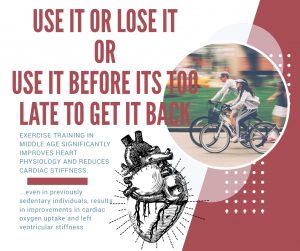EXERCISE TRAINING IN MIDDLE AGE SIGNIFICANTLY IMPROVES HEART PHYSIOLOGY AND REDUCES CARDIAC STIFFNESS
TAKE-HOME MESSAGE
* In this prospective study, investigators examined the long-term effects of high-intensity exercise training on left ventricular stiffness in middle-aged individuals. They recruited and randomized 61 previously sedentary participants (53±5 years); 34 participants were assigned to exercise training and 27 to an attention control. After 2 years of follow-up, 53 participants had completed the study. The participants in the exercise group had an 18% improvement in VO2max versus baseline, while the control group experienced a slight decline from baseline. Likewise, left ventricular stiffness decreased significantly from baseline in the exercise group; no change occurred in the control group.
* The researchers concluded that exercise training in middle age, even in previously sedentary individuals, results in improvements in cardiac oxygen uptake and left ventricular stiffness. Although this is only a physiology study, these findings could have significant implications for the prevention of heart failure with a preserved ejection fraction, which is strongly associated with left ventricular stiffness.
“Use it or lose it” vs “Use it before it’s too late to get it back”
Heart failure with preserved ejection fraction (HFpEF) is an increasingly common presentation of heart failure in older adults, and assumed to be due, at least in part, to reduced left ventricular compliance. Management of such patients is difficult, and only spironolactone is recommended as treatment for Heart failure with preserved ejection fraction. There are also no recommended strategies to prevent it.
Howden and colleagues from Dr. Benjamin Levine’s exercise research group at Southwestern Medical Center provide preliminary evidence that intense, prolonged exercise training improves cardiac compliance and may have a role in preventing Heart failure with preserved ejection fraction. These authors randomized equal numbers of men and women to an exercise training or control group. The exercise training group participated in a progressively more demanding exercise training protocol. By 6 months of training, this group had increased their training to where they were exercising 5 to 6 hours weekly, including two interval training sessions. These interval training sessions are called “4 x 4’s”; participants exercised intensely at 95% of their maximum heart rate for 4 minutes followed by 3 minutes of rest, all repeated four times. After 10 months of the study, training participants entered a maintenance phase where they only did one interval session per week. Controls participated in an attention control group, in which they did strength, flexibility, and balance training, but no aerobic training.
Both the training and control participants underwent sophisticated measurements of cardiac function before and after training. Cardiac hemodynamics were measured by right heart catheterization, and cardiac output was measured by acetylene rebreathing. Lower body negative pressure and saline infusions were used to alter cardiac filling and to construct cardiac pressure/volume curves.
A total of 28 training and 24 control particpants, or 52 of the 61 starters, completed the study. Maximal oxygen uptake increased 18% with exercise training and decreased slightly in the control group. There was a downward and rightward shift of the cardiac end-diastolic volume/pressure volume curves with exercise training, demonstrating reduced cardiac stiffness. Left ventricular end-diastolic volume increased with exercise training, but pulmonary capillary wedge pressure was not changed, demonstrating increased stroke volume with similar filling pressures. In sum, these data suggest a more compliant, less stiff, better functioning heart after the training.
This article is part of a series from this laboratory demonstrating that cardiac compliance decreases with age, but less so in lifelong athletes who have left ventricular diastolic function much like sedentary, younger individuals. These authors have also shown rapid decreases in cardiac compliance after age 65. They have also demonstrated that there is little change in left ventricular stiffness in older individuals after 1 year of exercise training. They suggest that the present study of individuals aged 45 to 64 years may have identified a “sweet spot” or an age when exercise training can alter cardiac stiffness and possibly reduce the risk of Heart failure with preserved ejection fraction.
This is an excellent physiologic study. There are limitations in that the participants did do a prodigious amount of exercise training. Granted, the amount of exercise was not markedly different than the 150 minutes per week of moderate exercise training recommended by the Centers for Disease Control, but it did include multiple sessions weekly and several interval training sessions. Also, the results are tantalizing because they demonstrate that such exercise training improves cardiac compliance, but there is no evidence from the study that the training actually prevents or delays Heart failure with preserved ejection fraction.
Nevertheless, the clinical utility of the study is that it should prompt clinicians to encourage patients to start an exercise training programs before it is too late. We should perhaps replace the phrase “use it or lose it” with the phrase “use it before it’s too late to get it back.”
At Botanica Medica our Naturopaths are well aware of the importance of exercise, a good diet and the effect it can have on your life both physically and mentally. They come across lots of interesting studies and are always updating their knowledge. If you would like to make an appointment with one of our Naturopaths call Botanica Medica on 8271-1827 today. They are only to happy to share the knowledge they have gained through their studies and patient outcomes, and get you feeling better. Botanica Medica is located at 97 Glen Osmond Road, Eastwood and appointments are available Monday to Saturday including some after hours.
Published in Primary Care and
1 other channel
Journal Scan / Research · January 26, 2018
Cardiology
Written by
Paul D Thompson MD


Recent Comments